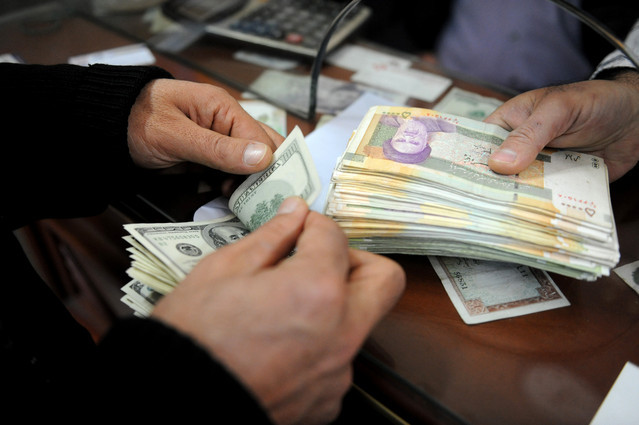One US dollar could well buy 40,000 rials by the next Iranian year starting in mid-March 2016, a local analyst says. On Thursday noon each USD fetched 33,900 rails in the Iranian free market.
The gap between the inflation rate(s) in Iran and the US will lift the greenback exchange rate by almost 10%. However, as the dollar is considered an economically sensitive and strategic currency, the government in Tehran cannot afford to apply the increase in a single move, the news website banker.ir quoted Amir Mohammad Khadivi, an independent market observer as saying.
If the administration continues to pursue the current “academic approach”, he claimed that the “official rate of the dollar in the 2016-17 budget law and the market rate will be 31,000 and 36,000 rials respectively .”
For 2016-17, Khadivi predicted an official rate of 34,000 rials and close to 39,000-40,000 rials as the market rate for the American currency.
Iran was forced to revert to the controversial double exchange rate regime after nuclear-related sanctions caused unprecedented turmoil in the forex market in 2011-12 in which the national currency lost almost 70% of its value within days. “The Rouahni administration has the ability to reduce foreign exchange rates but does apparently refuses to do so to support the country’s exports,” he said. “Lifting of sanctions should clear barriers to dollar trade and with attractive interest rates offered by banks, the foreign currency market will lose luster for investment.”
Paying for Wrong Policies
As for inflation target-setting, the expert called on the government to adjust the inflation target to current oil prices that have fallen dramatically since the initial target was set based on $100/barrel last year.
Admitting that the inept banking system has given rise to some wrong monetary decisions, he said “Economic problems of the country, however, are not the fruit of monetary policies alone. There also are other policies and decisions of the government that are simply not compatible with the existing situation.”
As an example, he referred to government royalties on iron ore mines that have are still very much in place while other countries had scrapped such procedures in light of declining iron ore prices.
On further interest rate cuts, Khadivi warned that this could lead to “capital flight from the banks.” He recalled that almost all lenders are saddled with burgeoning non-performing loans and are unable to cope with the situation as a large part of their assets is locked in the stagnant real estate market.
As a solution to the existing economic problems, Khadivi recommended the administration to use the released frozen assets on development projects and pay its huge debts to the banks and contractors. “This would help stimulate the stumbling economy and create jobs.”
He was referring to the almost $30 billion plus assets to be freed by foreign governments and companies soon after the nuclear deal signed by Iran and the six world powers in July comes into effect by early next year.


